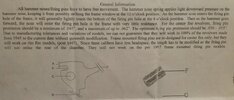Got to the range today to test the lower powder charge rounds. Didn't get a call from the LGS yesterday and they were closed today, so no factory ammo to compare.
Powder was measured with a new RCBS M500 beam scale calibrated immediately prior to loading, trickled up with a FA trickler so I'm confident there was very little variation in charge weight. Chronograph is a used Chrony F-1 with a fresh battery in it and diffuser screens deployed, but I was surprised at some of the the spreads in velocity. Time of day was 12:00 noon to 1:00 pm, so sun was about as close to vertical as possible. Benches at the range face due east, so sun was off to the right, and skies were clear. Temperature was 37 degrees F. I shot five groups of six shots, and recorded velocities were as follows:
12.2 grains AA#9
Min 1107 fps
Max 1166 fps
Avg 1136 fps
ES 59 fps
12.4 grains AA#9
Min 1093 fps
Max 1169 fps
Avg 1144 fps
ES 76 fps
12.6 grains AA#9
Min 1090 fps
Max 1226 fps
Avg 1178 fps
ES 139 fps
12.8 grains AA#9
Min 1078 fps
Max 1210 fps
Avg 1147 fps
ES 132 fps
13.0 grains AA#9
Min 1066 fps
Max 1243 fps
Avg 1179 fps
ES 177 fps
No pierced primers on any of the brass, and extraction was easy with just a tap of the extractor rod, with the exception of the 13.0-grain load, which took just a touch more effort to get the shells to drop out. 12.8 grains shot under 2", which is plenty good enough for me to hunt with at the ranges I'm limiting myself to. Of the half-dozen sources of load data I checked, three used this bullet and this powder (XTP 158-grain, AA#9), but only one used the same primer (CCI 550). Two indicated a max velocity over 1350 fps and one indicated max velocity of 1450+. (I would note that Speer's data, using their 158-grain JHP and AA#9 with a CCI 500 primer shows a max velocity of 1136 fps, though.) So I think I'm safe loading up 12.8 grains as my hunting load, with a max velocity just over 1200. Hornady indicates the 158-grain XTP will reliably expand without excessive fragmentation between 750 and 1400 fps, so bullet performance on game should be acceptable.
Still, it's a Model 19 and I don't want to beat it up. I definitely see a 6" barreled 586 or maybe a Model 27 in my future so I can save the 19 for targets.
I'm also curious about the increasing spreads in velocity as the charge increased. Is this normal for revolver loads? Does it indicate anything I should be concerned about? Interested to see if anything jumps out at others who know more about smokeless propellant behaviors than I.


